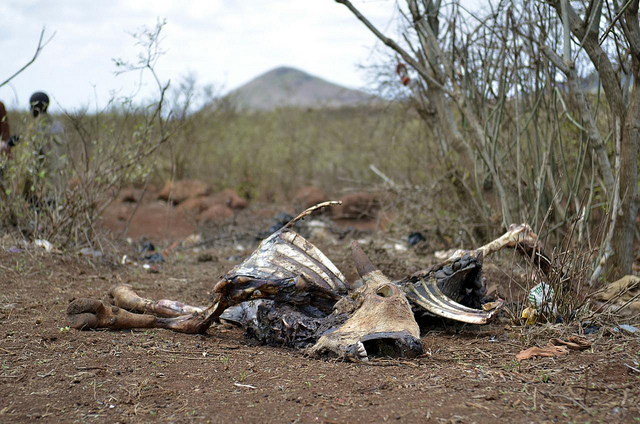Podcast: Play in new window | Download
Subscribe: RSS

A cow’s carcass in Northern Kenya, photographed last week, testifies to the reality of what happens when the water runs out. And it is running out. (Photo courtesy CIAT The International Center for Tropical Agriculture/Flickr)
The burgeoning world population, already grown far beyond the numbers the planet can sustain, is increasing its consumption of water twice as fast as it is growing, according to the World Resources Institute. In a world already profoundly short of clean water, where the number of people is ratcheting upward past seven billion, in which global climate change is spreading drought across vast areas, this means, in the words of a WRI expert, that “we have a significant challenge on our hands.” To translate from the scientese: her hair’s on fire and she’s screaming “Brace for Impact!”
Water shares a number of attributes with oil. It is, in a way, a fossil — all of it was created millions of years ago, and no more of it is being made today. Unlike oil, however, consuming water does not destroy it; the sum total of the water on the planet never changes. That’s the good news. The bad news is that 97% of it is too salty for human consumption (and too corrosive for most industrial applications), and two-thirds of the remainder is frozen. Life depends on the remaining one per cent. And agriculture and industry gobble up 90 per cent of that.
Our attitude toward water shares a number of attributes with our attitude toward oil: chiefly, a feckless disregard for the fact that we are using it up, and for the consequences of having used it all up.
In one of those stupid numbers tricks that try to drape guesses with mathematical certainty, statisticians “project” that water use will increase by 50 per cent in the developing world and 18 per cent in the industrial world, by 2025. The people who make these statements, and report them, must know that they are on their face impossible. There is simply no way to effect such an increase in available fresh water.
The Water Research Foundation tells Reuters that today, a billion people, one in seven, do not have access to clean water; that two billion people do not have adequate sanitation (which requires running water); and that five million people die every year as a result. With this in mind, along with the trends and “projections,” the executive director of the foundation says, “there’s a lot of water on Earth, so we probably won’t run out.”
Let us hope he was misquoted.
The tightening water supplies threaten the lives of millions of people now, and many more millions in the near future. The grim reality of that has not yet become apparent to the industrialized world, which is highly tolerant of the deaths of poor people. But it is not just their end of the boat that is sinking — or, to adjust the metaphor, running aground. Consider:
- Drought in Texas has reduced the cotton crop enough to cut into profits at The Gap by (a projected) 22 per cent;
- Kraft, Sara Lee and Nestle have announced increases in the prices of their food-like products largely because of drought;
- Depleted reservoirs threaten the water supplies of major American cities such as Las Vegas and Atlanta, and have reduced the amount of hydroelectric power produced in China this year by one quarter.
As with other major threats to the continued existence of life as we know it, climate change is acting here as a threat multiplier: we were squandering the resource long before climate change became apparent. It is also, of course, a threat multiplier for food shortages, energy shortages and political instability (another word for war).
Put it all together and you have — what is the phrase? “a significant challenge on our hands.”
-0-
[For updates on this and other Daily Impact stories, and for short takes on other subjects, check out The Editor’s Log.]